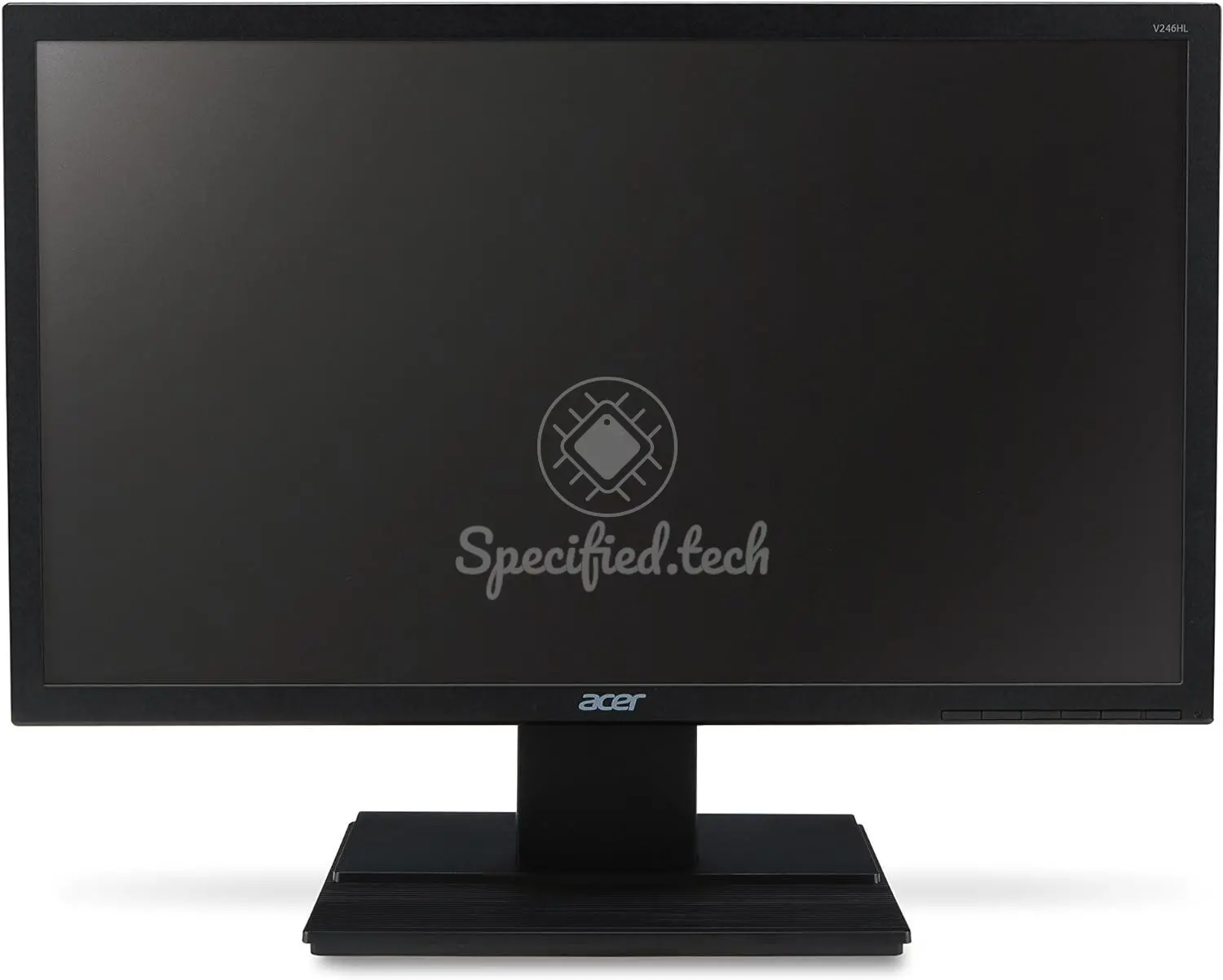
Today we will look at the monitor V246HL bd from Acer from the year 2013. Within this article, we will first take a closer look at the most important feature of a monitor -the display-, then the design, and in the next section we will go into the features of the monitor. Of course, power consumption, certifications, connectivity and other important details will also be considered.
Display
Games, texts, videos and/or other applications can be displayed on the monitor's 24 inches ( 60.9 cm on the diagonal). The size specification of a monitor refers to the screen diagonal, which is usually specified in inches. It is only comparable to a limited extent for different formats. For example, a conventional 4:3 monitor with the same screen diagonal has 6% less width, but 13% more height and a total of 7% more surface area than a monitor in 16:10 format. Despite the difference in working area, wider monitors are better suited for consuming games or current movies, for example. It is also easier to display several documents simultaneously on widescreen monitors. So, it depends on the current use case whether the aspect ratio of 1.778 : 1 makes sense for the intended use case. Approximately 83.3 % of the front surface of the monitor is covered by the display, while the remaining area consists of screen edges that do not allow any image output. If you want to set up several monitors next to each other, it is advisable to prefer models with the narrowest possible edges. The display is a TN panel. The panel has a resolution of 1920 x 1080 px. The pixel density is 91 ppi. The pixel pitch is 0.277 mm. The continuous possible brightness specified by the manufacturer Acer is 250 nt. The panel is illuminated by W-LED. The built-in panel ensures stable color reproduction of the image, even at deviating viewing angles, by means of its 170 ° (horizontal) viewing angle. Acer promises stable color reproduction moreover within a 160 ° vertical angle. The refresh rate is horizontally seen at the V246HL bd 30 khz to 80 khz. Vertically, however, the image renews at a minimum rate of 55 hz up to 75 hz. The minimum response time of the monitor is ms. The average response time of the monitor is about ms. The display panel is Anti-glare/Matte (3H).
Color representation
The panel has a bit depth of 8 per color channel, but what does that mean? The number of bits determines how many colors can be encoded for the individual pixels of the display. For an 8-bit panel, for example, this is 256 different colors (2^8 = 256). However, since we usually display three different colors per pixel at the same time, in theory about 16 million (256^3) different colors are possible by mixing the three pixels. A 10-bit panel could even display a billion colors. According to the manufacturer, the coverage of the NTSC 1953 color space is 72 %.
Contrast ratio
Contrast ratio is a common measurement used to represent the maximum relative differences in brightness between black and white. It describes the ability of a screen or projector to produce a high-contrast image and is the quotient of the maximum and minimum displayable luminance. The higher the values are away from each other, the stronger the quantitatively seen difference between black and white is set up, which in turn results in an improved image quality. This monitor from Acer has a static contrast ratio of 1000 : 1 , according to the manufacturer. In contrast to the static contrast ratio, the dynamic contrast ratio changes the brightness of the panel itself in addition to the difference measurement from black to white. In addition to the difference between the brightest and the darkest pixel, the backlight is thus changed. Since the brightness of the panel may not be able to be adjusted exactly to a single pixel, a so-called halo effect is possible. The value of 100000000 : 1 of dynamic contrast ratio for the monitor V246HL bd cannot provide any information about the severity of the halo effect here. Therefore, it is more useful to compare the static contrast ratio.
HDR
The monitor supports all HDR modes listed here:
screen design
For the installation of the monitor, a space requirement of approximately 33.5 cm in height, 56.7 cm in width and 5.2 cm in depth is to be assumed.
The size of the V246HL bd on the desk is likely to be particularly relevant for most users. Acer specifies a space requirement of 42.2 x 56.7 x 20.6 cm (HxWxD) with the included stand. The device weighs in total (i.e. also measured with the stand) 3.9 kg. According to Acer , you can expect a weight of about 3.5 kg without the stand. Speaking of weight without a stand and thus wall or table mounts. The monitor supports a Vesa mounting.
Rotate, tilt and swivel
The monitor from Acer cannot be rotated. The monitor cannot be swiveled. This feature could be retrofitted with a third-party stand. The monitor V246HL bd offers the option of adjusting the tilt as required to create an ergonomic working environment and reduce visual fatigue. The angle of inclination to the rear is 25. The monitor can be tilted forward by 5 degree.
Ports
The monitor can be connected via 1 VGA ports.
camera
This monitor does not have a camera.
Features
- The display/monitor supports Frame Rate Compensation.
Power consumption
On average, the monitor consumes approximately 20.5 w. The maximum power consumption (peak) specified for this monitor is 23 w. In standby mode, the device consumes approximately 0.45 w. When switched off, on the other hand, the monitor consumes only 0.35 w. The monitor can be operated on a 110v power supply. The monitor can be operated on a 220v power supply. The power grid has to supply a frequency of 50 hz to 60 hz.
Further information
- 100x100

